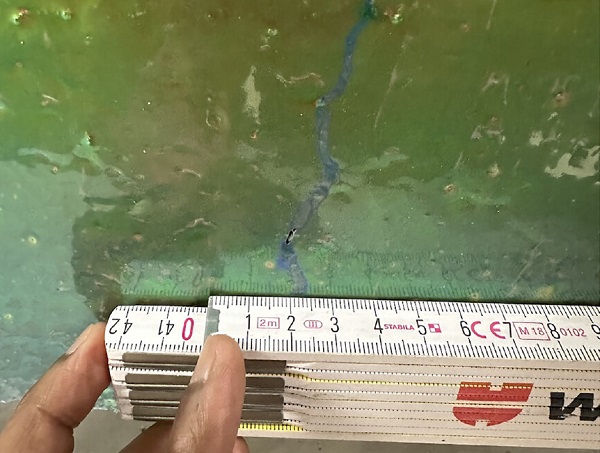 Even before the small crack in the middle became visible, the blue colour revealed its presence and helped monitor its spread, noted the University of Luxembourg;
Credit: Uni.lu
Even before the small crack in the middle became visible, the blue colour revealed its presence and helped monitor its spread, noted the University of Luxembourg;
Credit: Uni.lu
The University of Luxembourg has reported that it is co-developing an innovative coating of concrete to protect bridges.
Elastomers similar to paint coating developed at the University of Luxembourg and the Technical University of Darmstadt (Germany) have been proven to help detect and monitor potential concrete cracks of existing or future buildings. Much of the tunnels and bridge infrastructure in Europe are over 50 years old and are approaching end of life with important maintenance needs, posing the threat of more disastrous accidents such as the Morandi Bridge in Genoa in 2018 in Italy (43 deaths and sixteen injured), noted the University of Luxembourg.
Cost-effective and scalable, this technology could potentially have a revolutionary impact in the safety of critical infrastructure, such as bridges or dams.
‟Existing solutions and sensors don’t allow detection and monitoring at a reasonable cost, while our technology is cheap and only requires a camera as electronic equipment," explained Prof. Jan Lagerwall, Physicist at the Faculty of Science, Technology and Medicine of the University of Luxembourg.
The interdisciplinary collaboration of researchers and concrete engineering experts, published in the peer reviewed journal Structural Health Monitoring, demonstrated that crack formation could be revealed at a very early stage through a thin layer of these Cholesteric liquid crystal elastomers (CLCEs) that changes colour depending on the condition of the material, and could also be used to monitor the continued growth of the cracks, in order to act before potentially catastrophic consequences.
The university noted that the team is currently fine-tuning the chemical composition of CLCEs, which can be altered to different colours or stay invisible until there is a crack, to minimise its environmental impact. While initially targeted to concrete surfaces, the technology could also be easily applied to metal surfaces of moving vehicles, such as aircraft, boats, trains and cars.
“Together with Prof. Numa Bertola here at University of Luxembourg, we are now starting our first out-of-lab pilot experiment in the spring of 2025 on a real building with a bridge in Switzerland, as it’s very important to see how our solution fairs when exposed to outdoor conditions over long time," added Prof. Jan Lagerwall.
The team is currently exploring collaborations with additional partners, as well as potential commercial opportunities through intellectual property licensing.








